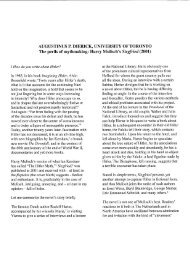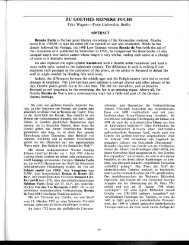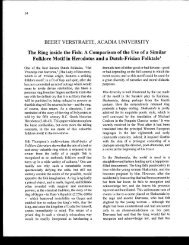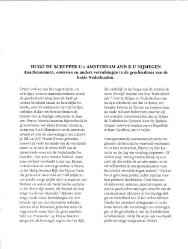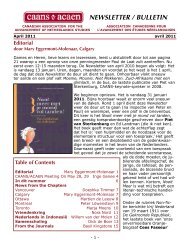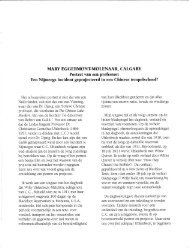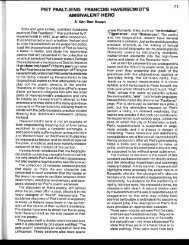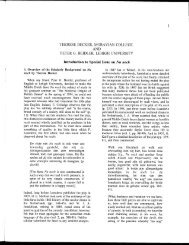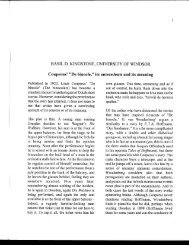MIEKE SMITS-VELDT - canadian association for the advancement ...
MIEKE SMITS-VELDT - canadian association for the advancement ...
MIEKE SMITS-VELDT - canadian association for the advancement ...
Create successful ePaper yourself
Turn your PDF publications into a flip-book with our unique Google optimized e-Paper software.
Images of two Dutch women: from seventeenth-century ideal to nineteenth-century myth 21 .<br />
peeped out from under <strong>the</strong> lid, under <strong>the</strong> eyes of<br />
his wife.<br />
Maria Tesselschade Roemer Visscher in <strong>the</strong><br />
17th century: <strong>the</strong> creation of a myth<br />
It was in fact her attitude during just one period of<br />
her life that made Maria van Reigersberch <strong>the</strong><br />
heroic wife par excellence already in her own time,<br />
provided with virtues like feminine courage,<br />
cleverness and loyalty. Maria Tesselschade, <strong>the</strong><br />
daughter of <strong>the</strong> Amsterdam merchant poet Roemer<br />
Visscher, however, born in 1594 and thus her<br />
junior by 4Yz years, was during her whole adult life<br />
praised <strong>for</strong> her all-round artistic talents, her lively<br />
charm and wit and feminine wisdom by several<br />
well-known poets. 6 Thanks to an all-round<br />
education, given by <strong>the</strong>ir liberal, learned and wellto-do<br />
fa<strong>the</strong>r, Tesselschade and her older sister<br />
Anna mastered <strong>the</strong> artistic techniques of drawing,<br />
<strong>the</strong> engraving of glass and ingenious embroidery,<br />
as well as those of making music and writing poetry.<br />
Both girls learned to speak and write French<br />
and Italian, but Tesselschade played more<br />
instruments than her sister, like <strong>the</strong> lute,<br />
harpsichord and <strong>the</strong> viola da gamba, and she<br />
apparently had a good singing voice.<br />
In itself such a variety of accomplishments was<br />
probably not so exceptional during a time when<br />
educated members of <strong>the</strong> upper middle class<br />
regarded <strong>the</strong> amateur practising of many arts -<br />
by men and women - as <strong>the</strong> creative selfexpression<br />
of harmonious. human beings endowed<br />
with an aes<strong>the</strong>tic sense. It was again by <strong>the</strong> work<br />
of poets that <strong>the</strong>se two· were immortalized. The<br />
mythologization started with poems <strong>for</strong> Anna, who<br />
<strong>for</strong> her unique combination of artistic gifts,<br />
knowledge and virtue was honored by <strong>the</strong> <strong>the</strong>n<br />
famous poet and classicist Daniel Heinsius, as well<br />
as by Jacob Cats and Joost van den Vondel.<br />
Vondel must have met both girls already in <strong>the</strong>ir<br />
youth in <strong>the</strong> Amsterdam home of <strong>the</strong>ir fa<strong>the</strong>r, a<br />
house that was also visited by o<strong>the</strong>r prominent<br />
Amsterdam poets like Gerbrand Adriaensz<br />
Bredero and Pieter Cornelisz Hooft. It was<br />
Hooft who introduced <strong>the</strong> diplomat Constantijn<br />
Huygens, from The Hague, into this<br />
literary circle. After her ra<strong>the</strong>r late marriage<br />
in 1624 Anna withdrew from <strong>the</strong> arts.<br />
Tesselschade married <strong>the</strong> retired naval officer<br />
Allard Crombalcn, but she had also found in<br />
I<br />
Hooft a literary/friend and guide <strong>for</strong> life. As a<br />
regular guest at Muiden Castle she also<br />
remained in contact with Hooft's friends <strong>for</strong><br />
<strong>the</strong> rest of her life. After <strong>the</strong> death of her<br />
husband, when she was 40 years old, she<br />
found a new admirer in Hooft's friend<br />
Barlaeus, <strong>the</strong> learned neo-Latin poet, while at<br />
<strong>the</strong> same time her contact with Huygens<br />
became more intense.<br />
Tesselschade's own poetry was only partly<br />
accessible, insofar as it was printed in<br />
anthologies. But as her literary friends did not<br />
hesitate to publish <strong>the</strong>ir poems <strong>for</strong> and on her<br />
in <strong>the</strong> editions of <strong>the</strong>ir work, she figured in<br />
public as <strong>the</strong> personal friend and bright Muse<br />
of <strong>the</strong>se great authors already in <strong>the</strong> 17th<br />
century. So her contemporaries could be<br />
in<strong>for</strong>med of <strong>the</strong> infatuation of <strong>the</strong> young poet<br />
and painter Bredero, who had died young, <strong>for</strong><br />
<strong>the</strong> lovely but unapproachable young<br />
Tesselschade; one could know <strong>the</strong> ligh<strong>the</strong>arted<br />
poetry by Hooft, Huygens and<br />
Vondel, written on <strong>the</strong> occasion of her<br />
marriage, and quite a few poems by Huygens.<br />
He wrote about <strong>the</strong> death of her husband and<br />
daughter, and after her conversion to <strong>the</strong><br />
Catholic faith he tried in vain to bring her<br />
back to Protestantism by means of sometimes<br />
highly critical poems. It was also Huygens<br />
who wrote a poem on her death in 1649, in<br />
which he warned his readers that nobody<br />
should dare use words "to take <strong>the</strong> measure<br />
of her invaluable qualities" (Laat niemand<br />
zich vermeten / Haar onwaardeerlijkheid in<br />
woorden uit te meten), since <strong>the</strong>re were no
22<br />
The Canadian Journal ofNe<strong>the</strong>rlandic Studies<br />
adequate words to describe <strong>the</strong> sun (AI wat men<br />
van de zon kan zeggen gaat haar at). 7 Meanwhile<br />
only Latin scholars were able to read Barlaeus'<br />
exalted poems on his admirable Muse, poems<br />
which he published when Tesselschade was still<br />
alive, namely in a special part of his collected Latin<br />
poems (1646), entitled "Tessalica." But especially<br />
V ondel' s dedication of his translation of<br />
Sophocles' Elektra to Tesselschade (1639) must<br />
have made quite an impression. In this text <strong>the</strong><br />
prince of <strong>the</strong> Dutch poets rendered hommage to<br />
<strong>the</strong> "wise and intelligent" (wijze en vernuftige)<br />
woman, who could understand his translation<br />
problems, because she herself was working on <strong>the</strong><br />
translation of Tasso's famous Italian epic poem<br />
Gerusalemme liberata (The liberated Jerusalem).<br />
V ondel praised Tesselschade' s literary qualities in<br />
poetic words referring to ''<strong>the</strong> sweet dew of subtle<br />
pieces of cleverness and spirited flowers"'(de<br />
lieflijke dauw van aardige spitsvondigheden en<br />
geestige bloemen) with which she refreshed "<strong>the</strong><br />
Dutch Pamassus". 8<br />
In <strong>the</strong> biography of Hooft by Geeraerdt Brandt<br />
(1677), Tesselschade received special attention as<br />
<strong>the</strong> "intelligerLt and virtuous poetess" (de<br />
schrandere en zedige dichteres) who had helped to<br />
tum Muiden Castle into a "Mountain of <strong>the</strong><br />
Muses," full of mirth. 9 But her role in <strong>the</strong> social<br />
ga<strong>the</strong>rings of Hooft's friends was yet to be<br />
established by <strong>the</strong> first publication of Hooft's<br />
letters by Balthasar Huydecoper, in 1738. This<br />
edition was to become an often quoted source of<br />
in<strong>for</strong>mation <strong>for</strong> several later generations, just as<br />
<strong>the</strong> biography of Grotius, dating from about <strong>the</strong><br />
same time, was to be used <strong>for</strong> <strong>the</strong> heroic facts of<br />
<strong>the</strong> life of Maria van Reigersberch.<br />
Maria van Reigersberch in <strong>the</strong> 18th century:<br />
political and national images<br />
The 18th-century biography of Grotius activated<br />
<strong>the</strong> memory of <strong>the</strong> great statesman, who just like<br />
Oldenbamevelt (and o<strong>the</strong>r adversaries and victims<br />
of <strong>the</strong> Orange policy) had long been venerated by<br />
those Dutch regents who were opposed to<br />
<strong>the</strong> power of <strong>the</strong> stadholder. When in <strong>the</strong><br />
thirties of <strong>the</strong> century playwrights started<br />
again to take <strong>the</strong>ir subjects from Dutch<br />
history, <strong>the</strong> story of Grotius and his wife<br />
(including <strong>the</strong>ir faithful maid Elsje) was<br />
dramatized as well, in several plays by<br />
Frederik Duim.1O<br />
But in <strong>the</strong> last quarter of <strong>the</strong> 18th century, <strong>the</strong><br />
"People of Loevestein" were to become an<br />
important issue in a political conflict between<br />
<strong>the</strong> so-called Patriots and <strong>the</strong> adherents of <strong>the</strong><br />
Oranges. The Patriots were republicans, who<br />
regarded <strong>the</strong>mselves as <strong>the</strong> just defenders of<br />
<strong>the</strong> "True Dutch freedom," which meant<br />
freedom of <strong>the</strong> autonomous cities and<br />
provinces against <strong>the</strong> political power of <strong>the</strong><br />
stadholder. Their political conflict with <strong>the</strong><br />
Orangists had already started in <strong>the</strong> ideological<br />
centre of <strong>the</strong> aristocratic Patriots around<br />
<strong>the</strong> Amsterdam professor Petrus Burmannus;<br />
ano<strong>the</strong>r member of this group was <strong>the</strong><br />
militant woman author Betje Wolff. Already<br />
in <strong>the</strong> sixties Burmannus used to give dinners<br />
in his house to commemorate <strong>the</strong> 17thcentury<br />
patriotic fighters against tyranny,<br />
including <strong>the</strong> solemn commemoration of <strong>the</strong><br />
escape of "Saint Hugo" from Loevestein and<br />
<strong>the</strong> birthday of Grotius' wife. ll In 1773 <strong>the</strong><br />
members of <strong>the</strong> enlightened Patriot society<br />
Concordia et Libertate listened, some of<br />
<strong>the</strong>m perhaps overcome by emotion, to a<br />
lecture by <strong>the</strong> Amsterdam merchant Jacob<br />
Ploos van Amstel, who told how during a<br />
(possibly imaginary) pilgrimage to Loevestein<br />
he had not been able to swallow his tears at<br />
<strong>the</strong> thought of Grotius' suffering in that "true<br />
temple of conjugallove.,,12<br />
The canonisation of <strong>the</strong> heroic fighters <strong>for</strong><br />
republican freedom in <strong>the</strong>se aristocratic<br />
Patriot circles went hand in hand with a more<br />
general uneasiness with <strong>the</strong> economic,
Images of two Dutch women: from seventeenth-century ideal to nineteenth-century myth 23<br />
intellectual, artistic and above all moral decline of<br />
<strong>the</strong> nation. This uneasiness expressed itself in <strong>the</strong><br />
idolization of all those 17th-century men and<br />
women who had to be examples <strong>for</strong> <strong>the</strong> recovery<br />
of national virtues like love of country, courage,<br />
reasonable religiousness, constancy, diligence and<br />
perseverance. Their lives were described in books,<br />
notably a lexicon in ten volumes in which a place<br />
was also reserved <strong>for</strong> some poets and a single<br />
poetess (of <strong>the</strong> 18th century; Tesse1schade had still<br />
to be rediscovered). Grotius and his Maria of<br />
course also figured in this lexicon, just like <strong>the</strong><br />
17th-century learned woman Anna Maria van<br />
Schuurman. That unmarried lady had once been<br />
praised <strong>for</strong> her knowledge and artistic accomplishments<br />
in poems by Cats and Huygens, but<br />
now she was ra<strong>the</strong>r condemned as a bluestocking,<br />
and accused of zealotry because of her conversion,<br />
late in life, to a religious sect. 13<br />
Creative artists also played an important rote in<br />
reviving <strong>the</strong> illustrious past. The Patriots would <strong>for</strong><br />
instance decorate <strong>the</strong>ir homes with bisque busts of<br />
<strong>the</strong> old republican heroes (among <strong>the</strong>m Maria van<br />
Reigersberch), but also with those of several naval<br />
heroes like Michiel de Ruyter and one of <strong>the</strong><br />
legendary woman Kenau Simons Hasselaar, who<br />
had led three hundred women of HaarlemJo keep<br />
<strong>the</strong> Spanish besiegers off <strong>the</strong> town walls by means<br />
of stones and pitch. These busts were fabricated<br />
around 1784 in <strong>the</strong> china factory of Loosdrecht.1 4<br />
And what would be more inspiring <strong>for</strong> <strong>the</strong> Dutch<br />
nation than <strong>the</strong> images of patriotic subjects from<br />
<strong>the</strong> glorious past, "supported by <strong>the</strong> magic of poetry"?<br />
These are <strong>the</strong> words of <strong>the</strong> Patriot poet Jan<br />
Nomsz in his preface to a 1785 volume with letters<br />
in verse, made "lP by him but supposedly written<br />
by well-known historical figures. 15 Nomsz<br />
presented Maria van Reigersberch as writing to<br />
her husband who had just been arrested. Here she<br />
was still <strong>the</strong> proud lioness who strongly advised<br />
her husband to keep his honor, just as she had<br />
refused to beg <strong>for</strong> mercy on his behalf. 16 The<br />
fictional letter belonged to <strong>the</strong> old literary<br />
genre of <strong>the</strong> heroine letter that became quite<br />
popular again in <strong>the</strong> literary <strong>association</strong>s that<br />
were founded -towards <strong>the</strong> end of <strong>the</strong> 18th<br />
century. So it comes as no surprise that later<br />
in <strong>the</strong> same year <strong>the</strong> Leyden society "Art is<br />
<strong>the</strong> product of love" (Kunst wordt door liefde<br />
verkregen) actu;dly held a literary competition,<br />
invltingl<strong>the</strong> members to write a letter<br />
from Maria van Reigersberch to her husband<br />
after he had escaped from prison. 17<br />
Meanwhile <strong>the</strong> French occupation of <strong>the</strong><br />
Dutch Republic stimulated a strong national<br />
feeling of solidarity without political discord.<br />
From now on Maria would be praised not as<br />
a lioness, but as a loyal and tender wife. The<br />
Loevestein story made its way into several<br />
paintings like <strong>the</strong> one by H.W. Beekkerk<br />
(who died in 1796), in which one sees <strong>the</strong><br />
famous couple depicted as in a marriage portrait:<br />
<strong>the</strong> wife standing, <strong>the</strong> man sitting ... in a<br />
chest.ls<br />
The story continued to be <strong>the</strong> subject of<br />
various literary genres and schoolbooks: first<br />
of a schoolbook and a play by <strong>the</strong> Haarlem<br />
bookseller and hack writer Adriaan Loosjes, 19<br />
and of an epic poem by <strong>the</strong> blind poetess<br />
/ Petronella Moens.2o Loosjes must have loved<br />
his subject, <strong>for</strong> in 1794 he even wrote a voluminous<br />
novel about a long part of <strong>the</strong> life of<br />
Grotius and Maria, from <strong>the</strong>ir marriage up to<br />
and including <strong>the</strong> successful escape. He<br />
already had to admit, however, that he had<br />
difficulty combining Maria's courage with her<br />
tenderness that he wanted to emphasize as<br />
we1L21 As Loosjes wanted to inspire <strong>the</strong> entire<br />
future generation, both rich and poor, with<br />
good Dutch virtues, he also seized <strong>the</strong> opportunity<br />
to present Maria's servant-girl Elsje<br />
van Houweningen as an example <strong>for</strong> <strong>the</strong> more<br />
humble classes of society. In 1794, during <strong>the</strong><br />
annual prize-giving ceremony <strong>for</strong> <strong>the</strong>
26<br />
The Canadian Journal ofNe<strong>the</strong>rlandic Studies<br />
emotions was admired so much, Tesselschade was<br />
described <strong>for</strong> instance by <strong>the</strong> young Jacques Perk<br />
as <strong>the</strong> object of Brederos passionate love. 35<br />
Be<strong>for</strong>e that time, in 1847, <strong>the</strong> two 17th-century<br />
women who toge<strong>the</strong>r were endowed with about all<br />
<strong>the</strong> qualities that a 19th-century woman ideally<br />
could possess, were brought toge<strong>the</strong>r in one<br />
painting by <strong>the</strong> historical painter Louis Moritz,<br />
who painted a feast in <strong>the</strong> circle of Muiden,<br />
comparable to <strong>the</strong> poetic image written by<br />
Spandaw. Moritz populated his painting not only<br />
with poets, but with scholars and several ladies as<br />
well. During a festive dinner in <strong>the</strong> hall of <strong>the</strong><br />
castle of Muiden, Tesselschade offers a rummer<br />
(undoubtdy engraved by herself) to <strong>the</strong> guest of<br />
honor Marla VC1n Reigersberch. Hooft raises his<br />
glass, while Vondel, <strong>the</strong> learned professor Vossius<br />
and probably Huygens are benevolently looking<br />
on, among o<strong>the</strong>r celebrities who were partly<br />
fashioned after existing portraits. 36<br />
It is <strong>the</strong> image of a dream, but we can be sure that<br />
Potgieter would have loved to take part in that<br />
dream, with his sister Sophie sitting at his side.<br />
Postscript<br />
Until <strong>the</strong> fifties of <strong>the</strong> 20th century generations of<br />
Dutch schoolchildren became familiar with <strong>the</strong><br />
Muiden Circle by means of one of <strong>the</strong> well-known<br />
school plates by Isings, "The Muiden Circle during<br />
a summer afternoon in 1632." The literary and <strong>the</strong><br />
musical aspects are both well. represented, with<br />
Tesselschade at <strong>the</strong> centre: Hooft reading from his<br />
Historien, Vondel listening, Huygens, Barlaeus<br />
and Jacob Cats as musicians. Cats, a 17th century<br />
literary celebrity who never in his life had been<br />
Hoofts guest, is now included as well, just like<br />
Tesselschades husband.<br />
Here we see <strong>the</strong> myth of 17th-century Dutch<br />
harmonious culture carried to extremes. This<br />
mythical image may have lost its power of<br />
persuasion, but it confirms <strong>the</strong> importance of a<br />
relationship with <strong>the</strong> past <strong>for</strong> <strong>the</strong> definition of<br />
ones own identity.<br />
NOTES<br />
1 Reinier Baarsen e.a. "De lelijke tijd " Pronkstukken<br />
van Nederlandse interieurkunst 1835-1895.<br />
[Catalogue of <strong>the</strong> exhibition] Rijksmuseum<br />
Amsterdam 1996, m< 86 (p. 208).<br />
/<br />
2 On <strong>the</strong> glorification of <strong>the</strong> Dutch Golden Age in <strong>the</strong><br />
late 18th and 19th centuries, cf. N.C.F. van Sas,<br />
"Nationaliteit in de schaduw van de Gouden Eeuw.<br />
Nationale cultuur en vaderlands verleden 1780-<br />
1914." In: De Gouden Eeuw in perspectiej Het beeld<br />
van de Nederlandse zeventiende-eeuwse schilderkunst<br />
in later tijd. Ed. F.Grijzenhout and H. van Veen.<br />
Nijmegen 1992, p. 86-106.<br />
3 In: Vondel. Volledige dichtwerken en oorspronkelijk<br />
proza. Ed. Albert Verwey, Mieke Smits-Veldt and<br />
Marijke Spies. Amsterdam 1986, p. 784.<br />
4 Hugo de Groot. "Aen sijn Huisvrouw M.<br />
Reygersberch, over sijn verlossingh uyt deeuwige<br />
gevangenis." In: Verscheyde Nederduytsche<br />
gedichten. Amsterdam 1651, p. 103-105.<br />
5 Caspar Brandt. Historie van het leven des Heeren<br />
Huig de Groot [ ... ]. En vervolgt tot zyn doodt door<br />
Adriaan van Cattenburgh. Dordrecht-Amsterdam<br />
1727.<br />
6 For <strong>the</strong> following data on Maria Tesselschade cf.<br />
Mieke B. Smits-Veldt. Maria Tesselschade. Leven<br />
met talent en vriendschap. Zutphen 1994.<br />
(References: p. 113-117).<br />
7 Constantijn Huygens. "Grafschrift van loff.<br />
Tesselschade Visscher." In: idem. De gedichten. Ed.<br />
J.A. Worp. IV. Groningen 1894, p. 154. (The spelling<br />
of <strong>the</strong> quotation has been adapted).<br />
8 Vondel. Volledige gedichten etc., p. 206.<br />
9 G.Brandt. "T Leeven van [ ... ] Pieter Comeliszzoon<br />
Hooft." In: G.Brandt & R: Anslo. Pieter Corneliszoon<br />
Hoojt, deez vermarde man. Ed. W.Hellinga and<br />
P. Tuynman. Amsterdam 1969.<br />
\0 Frederik Duim. De vlugt van Huig deGroot uit het<br />
slot te Loevestein. Blyspel. Amsterdam 1742<br />
(reprinted in 1746 and 1760). In <strong>the</strong> same year 1742<br />
Duim also published a dramatic trilogy about <strong>the</strong> fate
28<br />
The Canadian Journal ofNe<strong>the</strong>rlandic Studies<br />
Alberdingk Thijm. Werken. Ed. J.F.M. Sterck. Amsterdams-Gravenhage,<br />
vols. 9 (1908, p. 21-33, 93-107), 10 (1909,<br />
p. 247-315) and 14 (1909, p. 227-272). Cf. Lodewijk van<br />
Deyssel. De wereld van mijn vader. Ed. Harry G .M. Prick.<br />
Amsterdam-Brussels J 986, p. 216.<br />
35 Jacques Perk. Historische romantische schetsen. In:<br />
Betsy Perk. Jacques Perk, geschetst voor t jong Nederland<br />
der XXe eeuw [ ... ]. Amsterdam-Hilversum 1902, esp.<br />
"Even op t Muiderslot," p. 218-222. This romance<br />
still figures in two novels from <strong>the</strong> 1940s: A.M. de<br />
Jong, De volle vaandrig (1947) and Ro van Oven,<br />
Tesseltje (1939, 2d ed. 1948).<br />
36 This painting by Moritz is now part of <strong>the</strong><br />
collection of The Muiderslot, Muiden.<br />
...<br />
"



